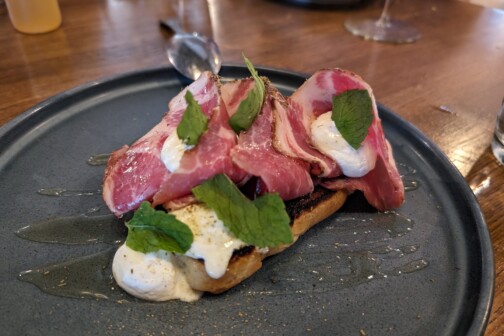So here we are with our demitasses of chicken broth, taking a break from one of the last great Dallas rituals extant, Neiman’s Last Call. Just a coupla food-critic chicks sittin’ around talking. About food, of course, because the main qualification for writing about food is talking about food, and talking is what my friend Nancy and I do best. Talk and push things around on our plate and wonder why, with all the food in all the restaurants in all of Dallas, more of what we eat isn’t good. We’re (just) old enough to lament great food gone: curly fries and bean soup at Jamie’s Hamburgers on Lemmon Avenue; Crabmeat Peggy at Mr. Peppe’s; cheese enchiladas at Guadalajara at 3 in the morning. We sigh and slather strawberry butter on another Neiman’s popover, one of the good things left. Then Nancy drops the memory bomb.
“Chili rice was very nice,” she says, triggering the long-neglected synapses that were storing that old slogan.
Shanghai Jimmy’s chili stand is gone, as is Blackie Sherrod, who immortalized Jimmy in his sports columns. (Okay, Blackie’s not gone gone, but you know what I mean.)
And that’s how the question came up: where has all the chili gone?
Chili used to be Dallas’ claim to Texas soul. Chili is as central to the canon of Texas culture as Travis’ line in the sand, longhorn trail drives, and UT football. And Dallas, ever the gustatory capital of Texas, had the chili-heads—not just the cooks but the scholars and philosophers of the chile pod and pot. Once upon a time, a bowl of chili and a package of Saltines were staples on every diner, drugstore, and cafe menu in town.
Today, even at Chili’s, chili is scarce. The Brinker-owned national chain started in Dallas 30 years ago as a little joint on Greenville Avenue that specialized in chili—by the bowl, on a burger, on a dog, smothering enchiladas, flooding nachos, folded into flour tortillas. Now it’s hard to find a bowl of red among the baby back ribs and Cajun chicken platters. (It’s listed under soups, of all places.) Jim Gauch, managing partner at what is now called “store No. 1,” says he still has loyal customers who order Terlingua Pride, chili tacos, and Chili’s Trip—a burger topped with sautéed onions, chili, and cheese. But these dishes are not on the regular menu.
You’d think, because of the gentrification and proliferation of Southwest food in the past several decades, and because of the concomitant specialization and proliferation of Southwest food journalists, we’d be hearing more about chili than ever. It is, after all, our state dish—so declared in 1977 by the Texas State Legislature, in one of its few comprehensible decisions. But no. So I decided to ask some questions.
I called Frank X. Tolbert II. In the ’50s and ’60s, Frank’s father was as famous for his strong opinions about Texas chili as he was for his column in the Dallas Morning News. (Okay, he was better-known for his chili opinions.) Tolbert wrote a book called A Bowl of Red about the myths and history of Texas chili. It is still the definitive word on the subject. And his Tolbert’s Chili Parlor once had several locations, but the last one closed in 2003.
“Artists, writers, lawyers, and bail bondsmen all gathered at Tolbert’s on Main Street,” says son Frank, who is now a noted artist but who used to be the Chili Parlor’s chief chili cook. “They were all drawn together by the power of chili. It’s the lingua franca of the Texas table. My father, a good journalist, always thought you didn’t know a person until you knew what he ate. In some sense, he thought good Texas writers are all food writers.”
Call me biased, but I am paid for my opinion, and I agree with Frank.
Next question: what constitutes a good bowl of red? To the uninitiated, it can be an off-putting dish—a bowl of brick-dyed mystery meat with a delicate sheen of grease on its surface. Plus, its reputation promises a degree of pain as part of the pleasure.
“For seven years, I cooked 40 gallons of chili a day. And made art,” Frank says. “A good bowl of chili is a complex thing. It is not wimpy. It’s hot. But it has to have several different levels of heat, not just one blast. There should be a variation from dark- to light-tasting chilis, and it needs to be cooked in the right progression.”
Frank prefers 85 percent lean chuck beef for his chili meat, because “chili demands fat.” He says he’s offended by cubed meat in chili. “I don’t know where that came from, but I can’t see cowboys cutting up their beef in neat little cubes.”
And, most important: no beans. This is not up for discussion.
It was dad Frank who fought in the Great Chili Wars of 1967, a battle over the bean issue that began in print. New York humorist and author H. Allen Smith (1906-1976) started the fracas with an inflammatory story in the August 1967 issue of Holiday magazine. It was titled “Nobody Knows More About Chili Than I Do,” and in it he proclaimed, “[N]o living man, I repeat, can put together a pot of chili as ambrosial, as delicately and zestfully flavorful, as the chili I make.”
The recipe that accompanied the piece called for two cans of kidney or pinto beans. This outraged Frank Senior, who responded to Smith’s first shot with a searing column in the Morning News. The feud quickly escalated, and it culminated in a chili cook-off between Smith and Dallas chili cook champ Homer “Wick” Fowler (a reporter, of course). It took place in the “neutral” territory of Terlingua, a West Texas ghost town. Legend has it the cook-off ended in a tie when Dave Witts, a Dallas lawyer and the self-proclaimed mayor of Terlingua, “spat out his chili, declaring that his taste buds were ’ruint,’ and said they would have to do the whole thing over again next year.”
Many people think of Terlingua ’67 as the first chili cook-off. Not true. It was the first live chili cook-off. The distinction of being the venue of the first ever chili cook-off properly belongs to Dallas. The World Champion Chili Cook-off at the 1952 State Fair of Texas was planned by Joe E. Cooper, another ex-newspaperman. Mrs. F.G. Ventura of Dallas won the contest. Her recipe was declared the “Official State Fair of Texas Chili Recipe,” and she was named the first ever “World Champion Chili Cook,” a title she held for 15 years.
Chili history emphasizes how pathetic it is that you can’t find real Texas chili in a Dallas restaurant today. But back to why.
Most chili historians agree that chili’s origins trace back to Texas trail cooks, the cocineros, who didn’t have a lot to work with except overly fresh beef, stringy and tough from walking all day, and whatever seasonings were cheap and portable. Dried chilies, for instance. Chili does not have an impressive pedigree. In fact, some of the most famous versions are jailhouse recipes. Chili scholar John Thorne theorizes that the whole reputation of Texas prison chili can be traced to “Sheriff Smoot Schmid’s Truly Fine Recipe for the Dallas County Jail.”
So chili is a distinctly déclassé dish. Its heritage is disadvantageous in a city so dependent on valet parking. Then there’s the business model of the dish.
“It’s a lot of trouble to cook a good pot of chili, and then you can only charge a couple of bucks for it,” says one Dallas chef when asked why chili is so hard to find here. (The chef would speak on such a controversial subject only when promised anonymity.) Maybe that accounts for its scarcity. It’s hard to gussy up chili enough to warrant a price hike and still be left with a dish that deserves the name. In an effort to lighten it up, stews are made with turkey, chicken, crawfish, even tofu seasoned with chile peppers. The last new edible version we remember was the venison chili on the menu at Southwest guru chef Stephan Pyles’ Routh Street Cafe. Most aficionados cook chili at home or compete in cook-offs in a kind of gonzo gastronomical world outside the CIA-staffed professional kitchens. Most aficionados.
I bear good news for the faithful. Because Frank X. Tolbert II has a sister by the name of Kathleen Tolbert Ryan. She owns Tolbert’s Texas Trading Company, one of the quaint stores lining Grapevine’s increasingly quaint Main Street. It’s stocked with all things Texana—chile-shaped bowls, chile pepper ornaments, pottery adorned with chile peppers—but no actual chili.
“People ask for it all the time,” Kathleen says. And that’s why she’s planning to revive a version of Tolbert’s Chili Parlor down a few doors on Main Street sometime next year. There will be more steaks, a classier atmosphere, but the same Tolbert taste to the chili. Her brother Frank will help perfect the recipe. The lease is already signed.
Old-timers like my friend Nancy and me have fat, fragrant memories of good chili and a taste for authenticity over novelty. And Tolbert’s in Grapevine gives chili-heads hope for a bowl in the future. So it seems fitting to borrow the words of the world’s best gonzo journalist to describe chili, outlaw cuisine. Like Hunter S. Thompson’s friend Dr. Gonzo, it seems that the genuine bowl of red is “too weird to live, too rare to die.”
Former D Magazine editor Mary Brown Malouf has been writing about the Dallas food scene for 20 years.





